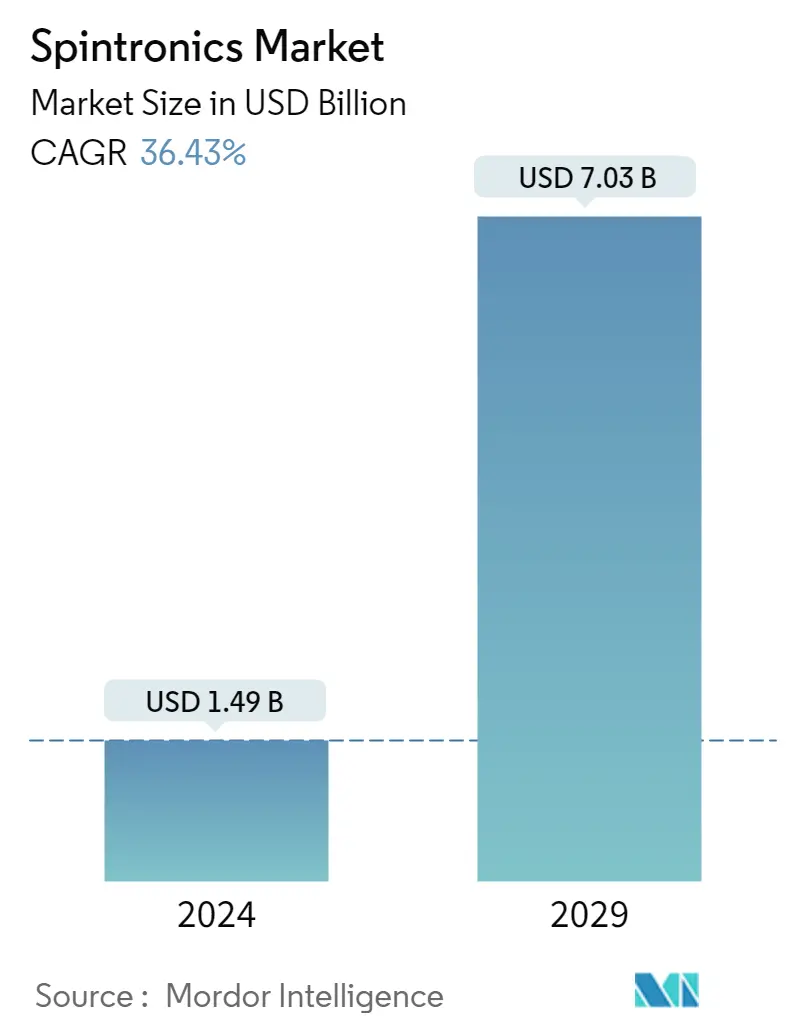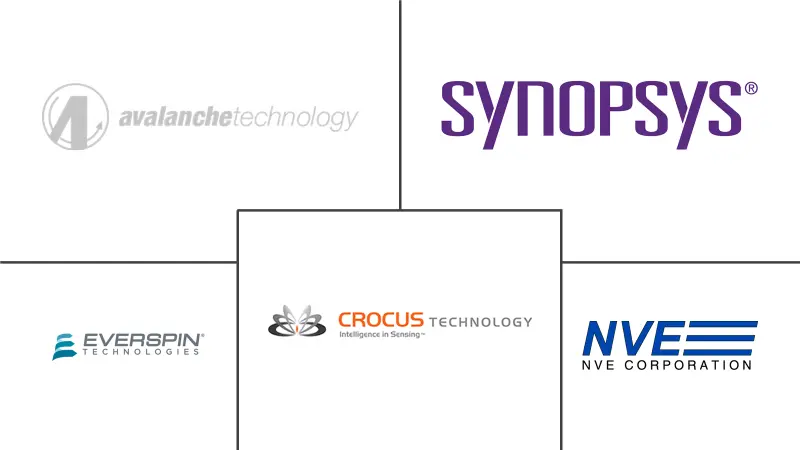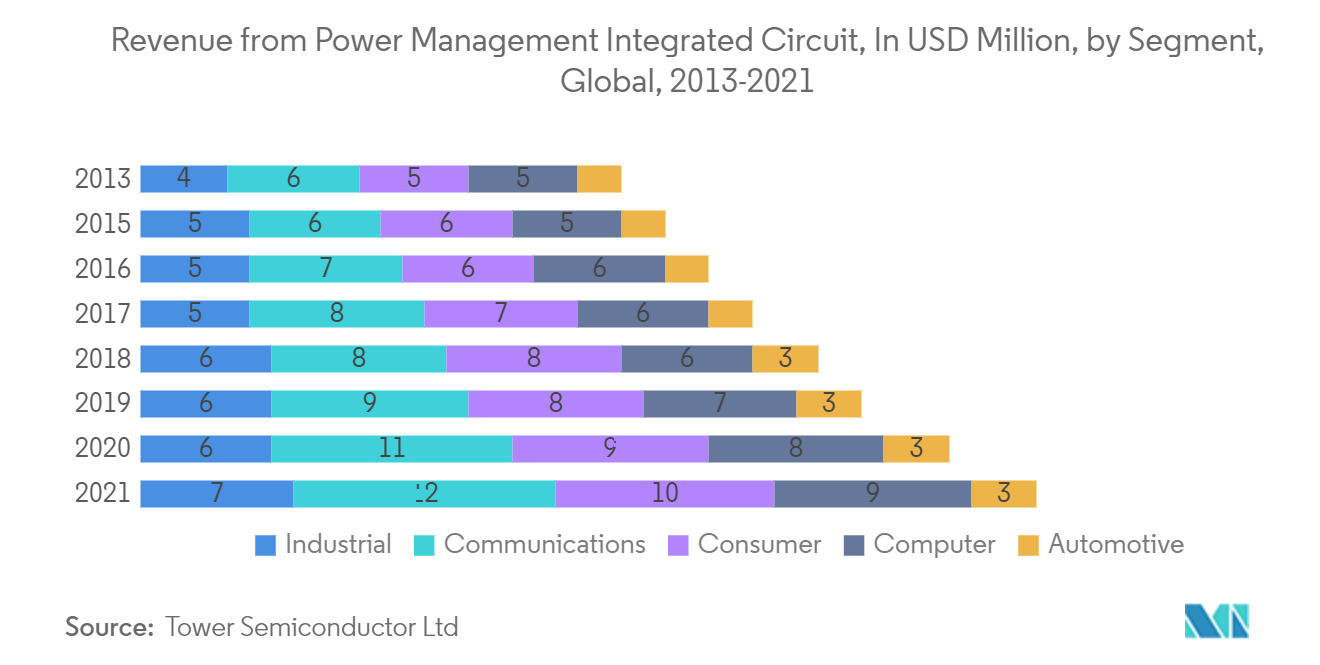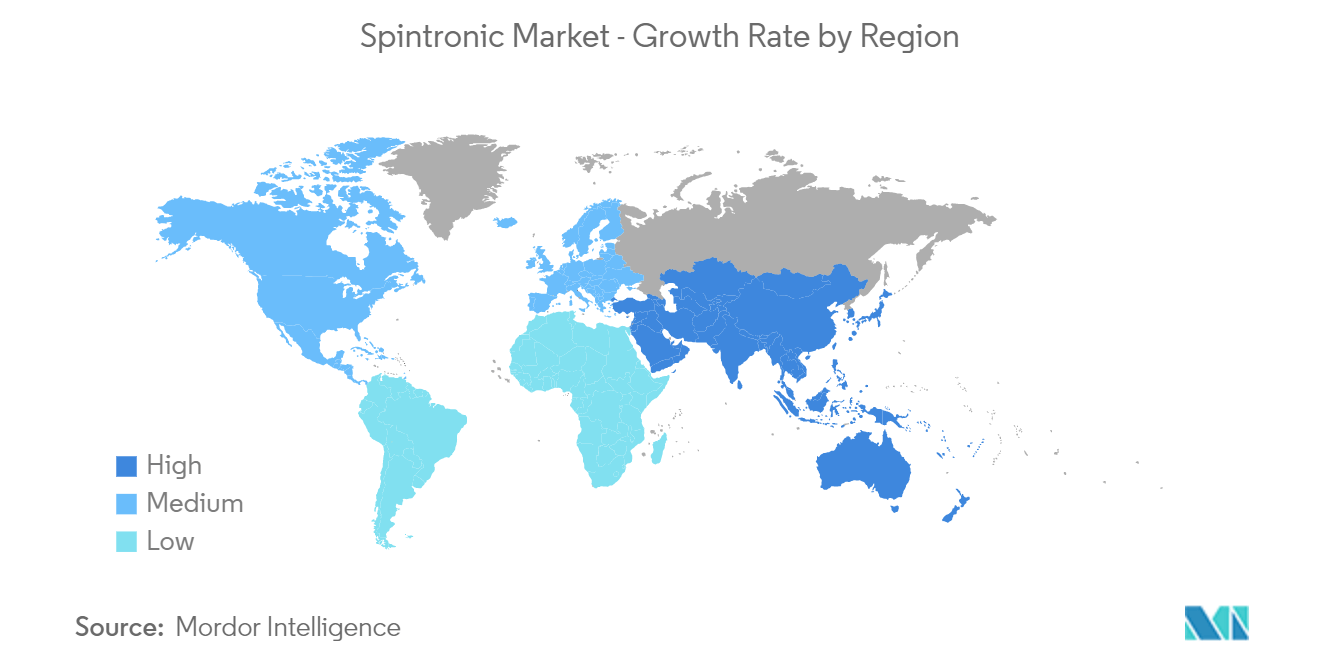Spintronics Market Size

| Study Period | 2017-2027 |
| Market Size (2023) | USD 1.09 Billion |
| Market Size (2028) | USD 5.15 Billion |
| CAGR (2023 - 2028) | 36.43 % |
| Fastest Growing Market | Asia Pacific |
| Largest Market | North America |
Major Players
*Disclaimer: Major Players sorted in no particular order |
Need a report that reflects how COVID-19 has impacted this market and its growth?
Spintronics Market Analysis
The Spintronics Market size is estimated at USD 1.09 billion in 2023, and is expected to reach USD 5.15 billion by 2028, growing at a CAGR of 36.43% during the forecast period (2023-2028).
The spintronics market is in its nascent stage, where a significant portion is still highly dependent on research and technological innovations. Moreover, the market's supply side was affected in the initial phase of COVID-19 due to nationwide lockdowns and factory closures worldwide. However, the scenario expanded the scope of the market studied as industries like data centres and cloud computing witnessed a massive surge in demand and adoption.
- The latest advances in spintronics technology are based on nanometric thin film structures with perpendicular magnetic anisotropy, in which the spin currents are utilized for producing changes in the magnetization of a magnetic layer. This effect is called spin-orbit torque (SOT), and it can be improved by engineering multilayer stacks composed of alternated magnetic or non-magnetic metals. These systems are the essential elements used for spin-orbit torque magnetization switching, utilized in the next generation of magnetoresistive random-access memory (MRAM) devices.
- For instance, the SpinOrbitronics research team guided by Dr. Paolo Perna at IMDEA Nanociencia observed the emergence of an interfacially enabled increase of the spin-orbit torque when an ultrathin Cu interlayer is inserted between Pt and Co in symmetric Pt/Co/Pt trilayer. The improvement of SOT is accompanied by a reduction of the spin-Hall magnetoresistance, showing that the spin memory loss effect in the Cu/Pt and Co/Cu interfaces is responsible for both enhanced SOT and a reduction in the spin-Hall magnetoresistance.
- In recent years, spintronics has been gaining momentum in the microelectronics market with the launch of industrial production from many significant players in the field (Samsung, INTEL, TSMC, and Global Foundries) of a new type of magnetic memory - MRAMs (Magnetic Random Access Memory). Comprehensive experimental efforts have been made to regulate electron displacement over long distances, although maintaining electron spin coherence after transfer remains challenging. Since individual electron spins can be displaced coherently over a distance of 5 µm, controlling the spin of electrons for long distances was challenging for the industry. Products integrated with spintronics technology have applications in electric vehicles, MRAM, industrial motors, and data storage, among other end users discussed within this report's scope.
- In the last few years, spintronics technology has also been extensively deployed in data storage devices due to its more active data transmission capabilities and increased storage capacities compared to conventional storage devices.
- At present, spintronic devices, for instance, magnetic tunnel junctions, suffer from limitations like low operating temperatures and severe constraints in material selection. To overcome these limitations, the market witnessed new research and development activities by organizations such as EURAMET. Practically, spintronics technology can consolidate the primary elements of magnetic storage devices and advanced semiconductor microelectronics or nanoelectronics in a single chip.
Spintronics Market Trends
This section covers the major market trends shaping the Spintronics Market according to our research experts:
Increasing Demand for Spintronics in Electronic Devices due to Lesser Power Consumption is Expected to Drive the Market
- It is expected that spintronics-based devices may replace electronic devices and offer more excellent performance at far low power levels. Electronic devices use electrons' motion for communication and power, whereas spintronic devices use a transferable property of stationary electrons, their spin, or angular momentum. Spintronics reduces the effort required to perform computational or memory functions.
- Researchers at the University of Tokyo reported that spintronics-based memory devices might offer high speeds at low power. Hence, they developed a new kind of memory based on spintronics that can quickly switch its magnetic state in the presence of an induced current at low power.
- In the last decade, spintronics technology has attracted tremendous attention due to its ability to solve the current problem of increased power dissipation in electronic circuits while scaling down the technology. Spintronics-based structures make it possible with low power consumption, zero standby leakage, infinite endurance, a good read and write performance, nonvolatile nature, and easy 3D integration capability, with the present-day electronic circuits based on CMOS technology. Trends like IoT and smart devices have increased the demand for memory components that can handle many functions at low power, expanding the scope of spintronics.
- As the global semiconductor industry has been consistently investing in developing future technologies by outlining developments in materials, systems, and devices that can maintain and enhance storage, and requires low power with increased computational capacity of current ICs, the scope of spintronics is expected to grow. US-based data storage company, Seagate Technology, has done research in spintronic memristor. Spintronics-based transistors may also replace electronic circuit boards with spintronics ones. Spintronics is one of the emerging fields in nanotechnology and has rapidly grown.
- Researchers using the Advanced Photon Source (APS), a United States Department of Energy Office of Science User Facility at DOE's Argonne National Laboratory, are studying methods to manipulate electron spins and develop new materials for spintronics.
- Recently, a researcher at the University of Alabama at Birmingham's Department of Physics received a three-year, USD 300,000 grant from the United States Department of Defense Air Force Office of Scientific Research for modeling and predicting the external pressure and strain that induce structural, topological, and magnetic transitions in magnetic topological systems. The success of this research is expected to help develop next-generation quantum metrology devices for low-energy consumption spintronics devices with topological currents.

North America is Expected to Hold a Major Market Share
- North America is one of the major investors and adopters in the studied market due to the high level of research done by regional companies and the increasing adoption of technologies among the regional end-user industries. Most of the major end-user industries in the spintronics market are highly advancing in the region, enabling the vendors to expand significantly over the forecast period. For instance, industries like electric automotive and transportation, data centers, enterprise storage, server RAID, industrial automation and IoT, and telecom infrastructure are significantly booming in the region, which is also fueling the need for advanced technologies like spintronics.
- Furthermore, most market vendors in the global market are US-based, which provides the region a massive competitive advantage and keeps it at the forefront of the studied market's innovation. Massive technology companies like IBM and Intel are playing a significant role in globally commercializing spintronics technology. For instance, recently, researchers at the United States Department of Energy's (DOE) Brookhaven National Laboratory and Yale University demonstrated the ability to control spin dynamics in magnetic materials by altering their thickness. A new study published in Nature Materials could lead to smaller and more energy-efficient electronic devices, representing a major advancement in spintronics.
- Electric vehicle use in the country has risen rapidly, with an estimated 1% of automotive sales in the US market coming from electric vehicles, according to the International Energy Agency (IEA). A notable increase in the demand for electric vehicles has been observed in North America due to energy and environmental concerns, accelerating the market for spintronics integrated into electric vehicles.
- The Zero Emission Vehicle (ZEV) program, undertaken in California, is also driving the demand for EVs by requiring automakers to sell a specific percentage of cars powered by electricity, thus fueling the market in the country. Last year, the US government announced its plan to replace its entire fleet of 645,000 cars and trucks with US-made electric vehicles and signed a "Buy America" executive order that creates new guidelines for the government's USD 600 billion in annual spending on goods and services. It is expected to boost the total number of EVs by at least 40% above the 1.6 million (including government- and privately-owned) currently on US streets.
- Moreover, in the United States, a wealth of private-sector companies, academic institutions, and federal research-and-development laboratories are focused explicitly on advancing nanotechnology and MEMS. The Institute for Soldier Nanotechnologies of the Massachusetts Institute of Technology (MIT), United States, founded by a USD 50 million contract with the United States Army Research Office, is a research center in Cambridge aimed to develop nanotechnology to improve the survivability of soldiers.

Spintronics Industry Overview
The spintronics market is characterized by steadily growing levels of product penetration, low product differentiation, and high levels of competition. Competitive advantage is heavily dependent on innovation. Some prominent market players, such as Avalanche Technology and Crocus Technologies, received funding to enhance their product innovation in recent years. Thus, the intensity of competitive rivalry is high.
- June 2022 - Renesas Electronic Corporation has announced the development of circuit technologies for an embedded spin-transfer torque magnetoresistive random-access memory (STT-MRAM) test chip with read and write operations fabricated using a 22-nm process.
- February 2022 - Researchers at the University of Manchester have improved the spin transport characteristics of nanoscale graphene-based electronic devices. In collaboration with Japan and internationally funded students from Ecuador and Mexico, the researchers from National Graphene Institute have made an extremely high-quality graphene channel, reducing the interference or electronic ‘doping’ by traditional 2D tunnel contacts.
Spintronics Market Leaders
NVE Corporation
Everspin Technologies Inc.
Crocus Technology
Synopsys (QuantumWise)
Avalanche Technology
*Disclaimer: Major Players sorted in no particular order

Spintronics Market News
- December 2022 - Researchers at Tohoku University, the University of Messina, and the University of California, Santa Barbara (UCSB) have developed a scaled-up version of a probabilistic computer (p-computer) with stochastic spintronic devices that is suitable for complex computational problems like combinatorial optimization and machine learning.
- September 2022 - Avalanche Technology has announced the availability of new High-Reliability Persistent SRAM (P-SRAM) memory devices through UMC’s 22nm process technology. The third-generation product platform offers significant density, endurance, reliability, and power benefits over existing non-volatile solutions using Avalanche’s latest Spin Transfer Torque Magnetoresistive RAM technology.
Spintronics Market Report - Table of Contents
1. INTRODUCTION
1.1 Study Assumptions and Market Definition
1.2 Scope of the Study
2. RESEARCH METHODOLOGY
3. EXECUTIVE SUMMARY
4. MARKET INSIGHTS
4.1 Market Overview
4.2 Industry Value Chain Analysis
4.3 Industry Attractiveness - Porter's Five Forces Analysis
4.3.1 Threat of New Entrants
4.3.2 Bargaining Power of Buyers
4.3.3 Bargaining Power of Suppliers
4.3.4 Threat of Substitute Products
4.3.5 Intensity of Competitive Rivalry
4.4 Assessment of the COVID-19 Impact on the Market
5. MARKET DYNAMICS
5.1 Market Drivers
5.1.1 Increasing Demand for Spintronics in Electronic Devices, Due to Lesser Power Consumption
5.1.2 Rising Need for Higher Data Transfer Speed and Increased Storage Capacity
5.2 Market Challenges
6. SPINTRONICS PATENT LANDSCAPE
7. MARKET SEGMENTATION
7.1 Type of Device
7.1.1 Metal-based Devices
7.1.1.1 Giant Magneto Resistance-based Device (GMRs)
7.1.1.2 Tunnel Magneto Resistance-based Device (TMRs)
7.1.1.3 Spin-transfer Torque Device
7.1.1.4 Spin-wave Logic Device
7.1.2 Semiconductor-based Device
7.1.2.1 Spin Diode
7.1.2.2 Spin Filter
7.1.2.3 Spin Field-effect Transistor (FETs)
7.2 Application
7.2.1 Electric Vehicle and Industrial Motor
7.2.2 Data Storage/MRAM
7.2.3 Magnetic Sensing
7.2.4 Other Applications
7.3 Geography
7.3.1 North America
7.3.2 Europe
7.3.3 Asia-Pacific
7.3.4 Rest of the World
8. COMPETITIVE LANDSCAPE
8.1 Company Profiles
8.1.1 NVE Corporation
8.1.2 Everspin Technologies Inc.
8.1.3 Crocus Technology
8.1.4 Synopsys (QuantumWise)
8.1.5 Avalanche Technology
- *List Not Exhaustive
9. INVESTMENT ANALYSIS
10. FUTURE OF THE MARKET
Spintronics Industry Segmentation
Spintronics, also known as spin electronics, studies the intrinsic spin of the electron and its associated magnetic moment, in solid-state devices, in addition to its fundamental electronic charge. The field of spintronics concerns spin-charge coupling in metallic systems, while the analogous effects in insulators fall into multiferroics.
The spintronics market is segmented by type of device (metal- and semiconductor-based devices), application (electric vehicles and industrial motors, data storage/MRAM, and magnetic sensing), and geography. Key base indicators considered for the study are data storage trends, GDP, electric vehicle growth, current trends, and several other key economic indicators. The market sizes and forecasts are provided in terms of value (USD million) for all the above segments.
| Type of Device | ||||||
| ||||||
|
| Application | |
| Electric Vehicle and Industrial Motor | |
| Data Storage/MRAM | |
| Magnetic Sensing | |
| Other Applications |
| Geography | |
| North America | |
| Europe | |
| Asia-Pacific | |
| Rest of the World |
Spintronics Market Research FAQs
How big is the Spintronics Market?
The Spintronics Market size is expected to reach USD 1.09 billion in 2023 and grow at a CAGR of 36.43% to reach USD 5.15 billion by 2028.
What is the current Spintronics Market size?
In 2023, the Spintronics Market size is expected to reach USD 1.09 billion.
Who are the key players in Spintronics Market?
NVE Corporation, Everspin Technologies Inc., Crocus Technology, Synopsys (QuantumWise) and Avalanche Technology are the major companies operating in the Spintronics Market.
Which is the fastest growing region in Spintronics Market?
Asia Pacific is estimated to grow at the highest CAGR over the forecast period (2023-2027).
Which region has the biggest share in Spintronics Market?
In 2023, the North America accounts for the largest market share in the Spintronics Market.
Spintronic Devices Industry Report
Statistics for the 2023 Spintronic Devices market share, size and revenue growth rate, created by Mordor Intelligence™ Industry Reports. Spintronic Devices analysis includes a market forecast outlook to 2028 and historical overview. Get a sample of this industry analysis as a free report PDF download.
